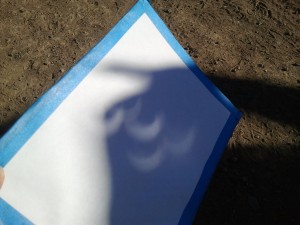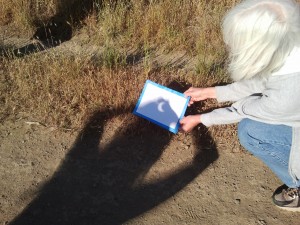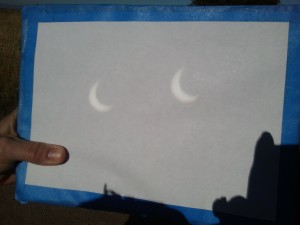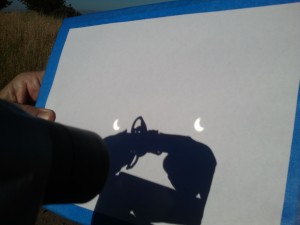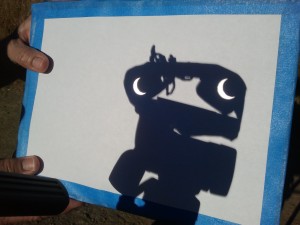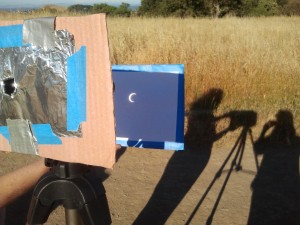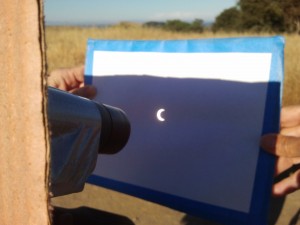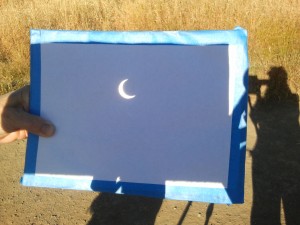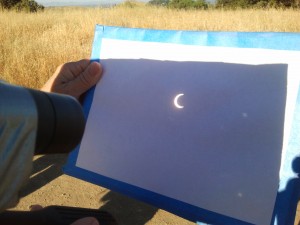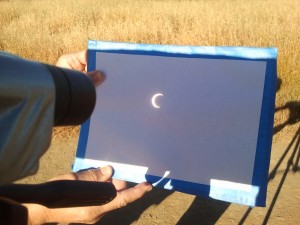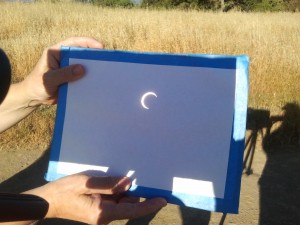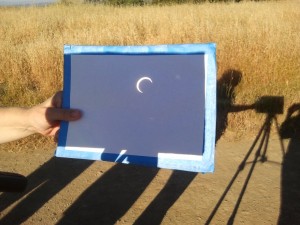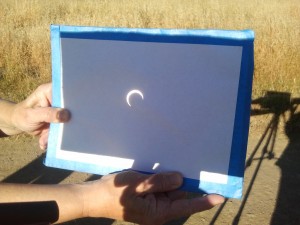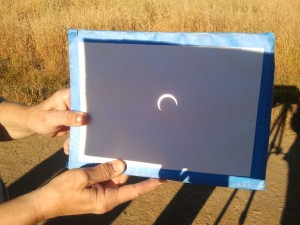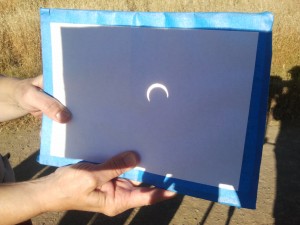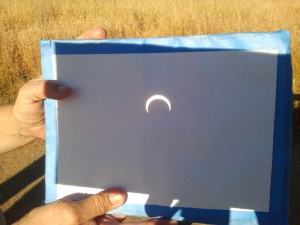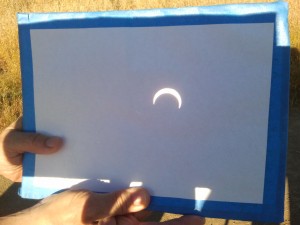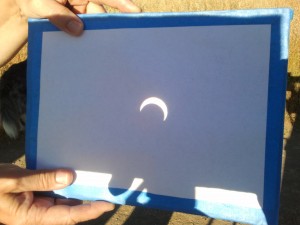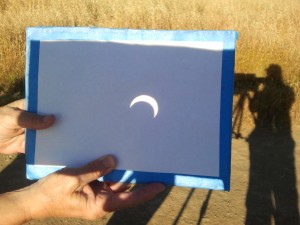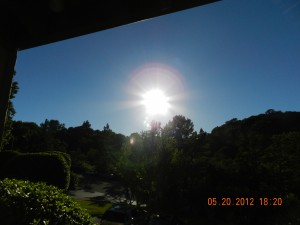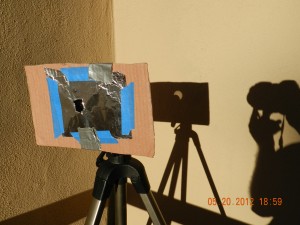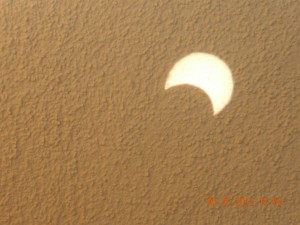Blog
The Eclipse: A Story in Pictures
Posted by Jennine Lanouette on Tuesday, May 22nd, 2012
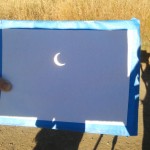 Last Saturday night, my friend Judy said to me, “I want to watch the eclipse tomorrow.”
Last Saturday night, my friend Judy said to me, “I want to watch the eclipse tomorrow.”
“Why don’t you come over,” I said, “and we can climb to the top of the ridge above my house.”
“Great,” she said.
But I woke the next morning wondering just how we were going to do this. So I sent her a text.
Me: Good morning, Judy. How do you plan to view the eclipse without solar glasses?
Judy: I hadn’t thought about that. But I remember something like a shoebox pinhole camera thing. And it will definitely darken the sky. So that will save us from being burned at the stake.
Me: Didn’t think I was at risk of being burned at the stake today. Got any welder’s goggles?
Judy: Maybe. Garth has every tool known to man.
Me: Okay. Ed just wants to watch it on TV. But you and I can pass the goggles between us.
Judy: Okay. If I can’t find Garth’s goggles, we can make a pinhole thingy.
Me: Great.
I went on line and found some rather complicated instructions on how to make a pinhole projector, kind of like a grade school science project. Forget that, I thought. Maybe we’ll get lucky with the goggles.
A little after 5:30, I heard Judy drive up. I went to my deck and saw her standing in front of my house holding a piece of white paper in one hand and a corrugated cardboard with a crudely punched hole in the other, both in direct line with the sun. “I can see it!” she called out. “It’s a little crescent shape.” Clearly, she had not found any goggles but I was impressed with her alternate strategy.
When she got inside, I asked, “How did you know to try that?” “I’m a scientist’s daughter,” she said. That may be, but, seeing the ragged hole in her cardboard, I knew her design could be improved. “For the best view, the hole has to be perfectly round,” I told her. “And the way to do that is to poke a hole in a piece of tinfoil with a pin or a nail.” I went to the kitchen to get the tin foil. “I know!” I said, “We can cut out a square in your cardboard and tape some tin foil over it.” “Great idea!” she said. “How did you think of that?” “I’m an engineer’s daughter,” I told her. Then I saw she had brought extra cardboard. “Let’s tape the white paper to a cardboard to make a more stable screen,” I said.
As we prepared our apparatus in the kitchen, Ed called from the living room that the light was changing. He was on the couch with his computer, looking for a place to view the eclipse on line. He clicked on a video of a guy telling how to see it through binoculars. We had him play the clip three more times so we could study it. Then I went to the closet for Ed’s binoculars, upstairs for his tripod and back to the kitchen for the gaffers tape. And we were out the door.
On our way up the hill, we passed my neighbor Sophie, in the street with her kids. She pointed to the shadows of a tall oak tree on the pavement. “You can see the eclipse in the leaves,” she said. We came around to her perspective, looked down at where she was pointing and saw many, many crescents, dancing in the street. (You know how, for some optical reason, sunlight comes through tree leaves in perfect circles? Because of the eclipse, those circles became crescents.) Suddenly, the eclipse took on a weirdly cosmic feeling.
When we reached the flat stretch of fire road along the top of the ridge, there were already numerous other eclipse watchers set up with their shoeboxes, long thick tubes, large rectangular boxes and cameras. We carefully picked out our spot among the crowd, like we were at the beach, putting down our stuff and setting up our tri-pod.
While I was securing the binoculars with tape, Judy met some watchers who were disappointed with their own crude equipment. So she showed them how to interlace their fingers overhead to create the same multiple crescent effect as we had seen in the tree shadows.
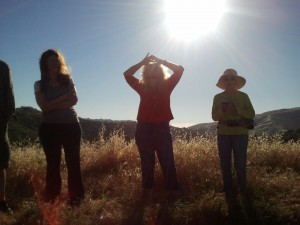
I grabbed our white cardboard screen. And there it was:
We impressed a few passersby with that.
But we had bigger plans. We went back to our tripod and pointed the binocs at the sun.
Holy cow! It works! I had shoved my cell phone in my pocket not even thinking about taking pictures. But when this image appeared, I suddenly became very concerned with getting a quality photograph. I brought the screen forward to make the crescent brighter, but had trouble maneuvering around the shadow of the binocs.
Then I discovered that if I put the image inside the shadow, it became much sharper and brighter. That was very cool, except for the Wall-E effect.
I said to Judy, “If only we could extend the shadow to cover the whole screen. I wish we had some kind of mask.” I looked around. “I know! The cardboard with the tinfoil!” Judy got it from our bag, along with the nail we brought. We tore a hole just big enough for one lens to see through and affixed the cardboard to the binoculars with gaffers tape. Then Judy held up our white paper screen and – Voila! – I took a picture.
But I wondered if we could improve the image a bit.
In a sudden inspiration, I had the bright idea to see if adjusting the focus on the binocs would help. Oh, yeah. That’s better.
Then I had to adjust the tripod cause the crescent had crept up the screen. “It keeps moving!” I said with exasperation. “Yeah, the sun does that,” said Judy. “Right. I forgot.”
For the next 40 minutes, we watched the bright white crescent slowly rotate as the moon crossed the sun.
We were so proud of our set up, we invited all strolling-by watchers to come take a look. “Ten cents a peek!” I called out. They would saunter over wearily, anticipating another tiny, blurry, dim image like what they found inside their old brown box. But on seeing our crescent, they were suddenly impressed. “Wow! That is a good picture!”
Then came a man who, when we braggingly said, “Want to see our picture?” responded with, “Want to get a direct look?” while holding out two pairs of solar glasses. “Yeah!” we both exclaimed as Judy dropped our white screen and I shoved my phone in my pocket.
Quickly placing the flimsy cardboard over my ears, I looked through the black lens at a luminous orange bucket crescent, hanging in dark nothingness. How liberating, to look directly at the sun. Gotta show this to Ed. I pulled my phone back out and held it up with the solar glasses over the camera lens. But I only got a message in my face that I’d run out of battery. Darn.
The solar glasses also reminded us that our image was upside down. “Why does it do that?” Judy asked. “Some lens thing about light refraction,” I said, thinking, “I should know this. I went to film school.”
It had gotten suddenly cold when the light started to dim. So, with no more pictures left to take, we packed up and headed back to the house. We wanted to show Ed our contraption while we could still get an image on the front deck. When we arrived, the sun was just over the trees.
We set up the tripod to project onto the stucco wall.
And Ed took a picture of the now waning moon.

